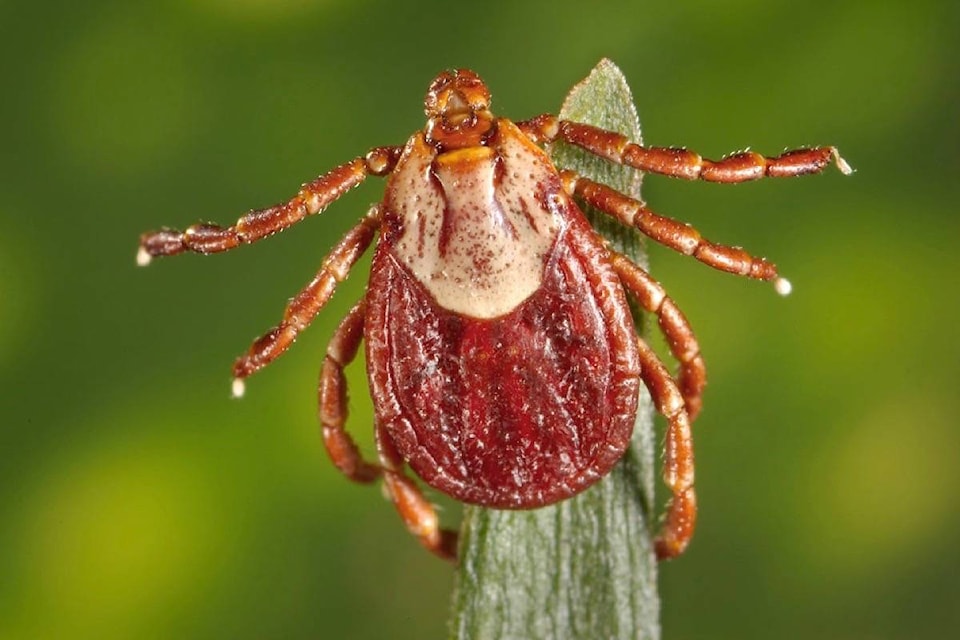Ticks have been out in full force in the region since March, and while the height of tick season usually comes in June, the pesky creatures can be found any time of year, warns Vanessa Isnardy, Provincial Coordinator for WildSafeBC.
“They keep going longer here, unfortunately,” she says. “We’ve had quite a few tick reports from different parts of the province.”
If there is one creature that does not respect physical distancing, it’s ticks, which will hitch a ride on any host that it comes into contact with.
“They don’t fall from above; they’ll climb to the top of a branch and go questing,” says Isnardy. “They’ll wait for an animal to go by that they can transfer to.” That “animal” can easily be a human, and ticks can often be found at the base of the neck or at the hairline.
The most common type of tick in the Interior is the Rocky Mountain wood tick, which has a wide distribution zone. It contains a toxin in its saliva that can cause paralysis, and Isnardy says that a child in the Lower Mainland was paralyzed following a bite.
“If you remove the tick early enough the condition reverses, and people and animals recover, but it can be fatal. That’s why it’s good to know about preventive measures.”
The Western black-legged tick is the other most common tick in the region that bites people, and it is known to carry Lyme disease. However, it is believed that prevalence is less than one per cent, and most ticks that carry Lyme disease are found on the coast and west of Boston Bar.
Isnardy says there are ways to protect yourselves from ticks. “Stick to trails, and avoid grassy areas. Wear light-coloured clothing so you can see ticks when they’re on you, and tuck your pants into socks or wear gaiters. Apply insect repellent that contains Deet to your clothing, not to your skin.”
She also advises people to be wary if you’re walking along game trails or habitat that contains rodents. “Very often rodents are part of a tick’s life cycle, because they need a host, and ticks are associated with small mammals here.”
After being in the bush or deep grass, do a tick check on yourself, as well as on children and pets, before you get into your vehicle or go indoors. Inspect your hairline, scalp, under your armpits, behind your knees, and any other hiding places. When you get home, hang your clothes over a chair, as ticks will make their way to the top. You can also throw clothes in a hot dryer for 10 minutes, which will kill any ticks.
Isnardy says that if your pet gets a tick, it can transfer to a human. “You want to avoid a pet bringing ticks into the home. Pets can get Lyme disease as well. You can get tick medication for your pet, so check with your vet as to which is best for you and your lifestyle.” Some people like to get a pill that is good for three months, while others prefer topical ointments. “It’s whatever works best for them.”
As with people, pets should be inspected before they get into your vehicle or come into the house. “You have check under their armpits, and get a comb and give them a really good combing. It can be hard to spot them, especially on a black dog, as ticks are so small.”
If you, your child, or a pet has been bitten by a tick, and it can be removed, Isnardy suggests putting it in a sealed container and storing it in the fridge. The tick will usually stay alive, and if symptoms such as muscle aches, fatigue, a bulls-eye rash, fever, or paralysis develop (usually within three to 30 days after being bitten), you should visit a health care professional. If the tick is still alive, it can be tested.
Ticks can be safely removed at home if they are caught early, before they get too embedded. “Take a pair of tweezers and get as close to the head of the tick as possible, at the base where the tick is attached to skin. Pull straight up — don’t twist — because you want to get the head out. If you leave it in, it can get infected. Disinfect the site with antiseptic cream.”
Isnardy adds that if the tick is not removed properly, or is deeply embedded, you might have to see a doctor. “Don’t go digging around. Get it at the base and pull it straight out, don’t squeeze it, then wash the wound.”
Ticks taper off after June, but Isnardy says people should still be vigilant after that.
“Never take anything for granted. Anytime from March through to winter, there’s always a chance you’ll go into a place with ticks.”
editorial@accjournal.ca
Like us on Facebook and follow us on Twitter
